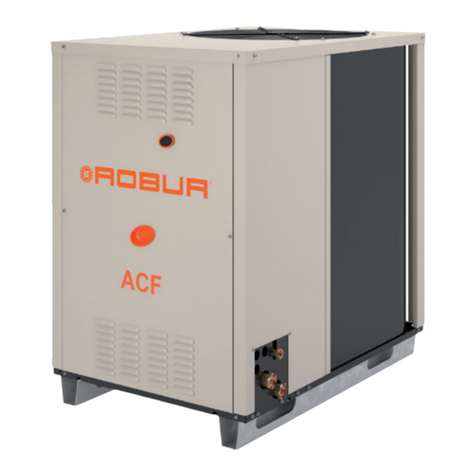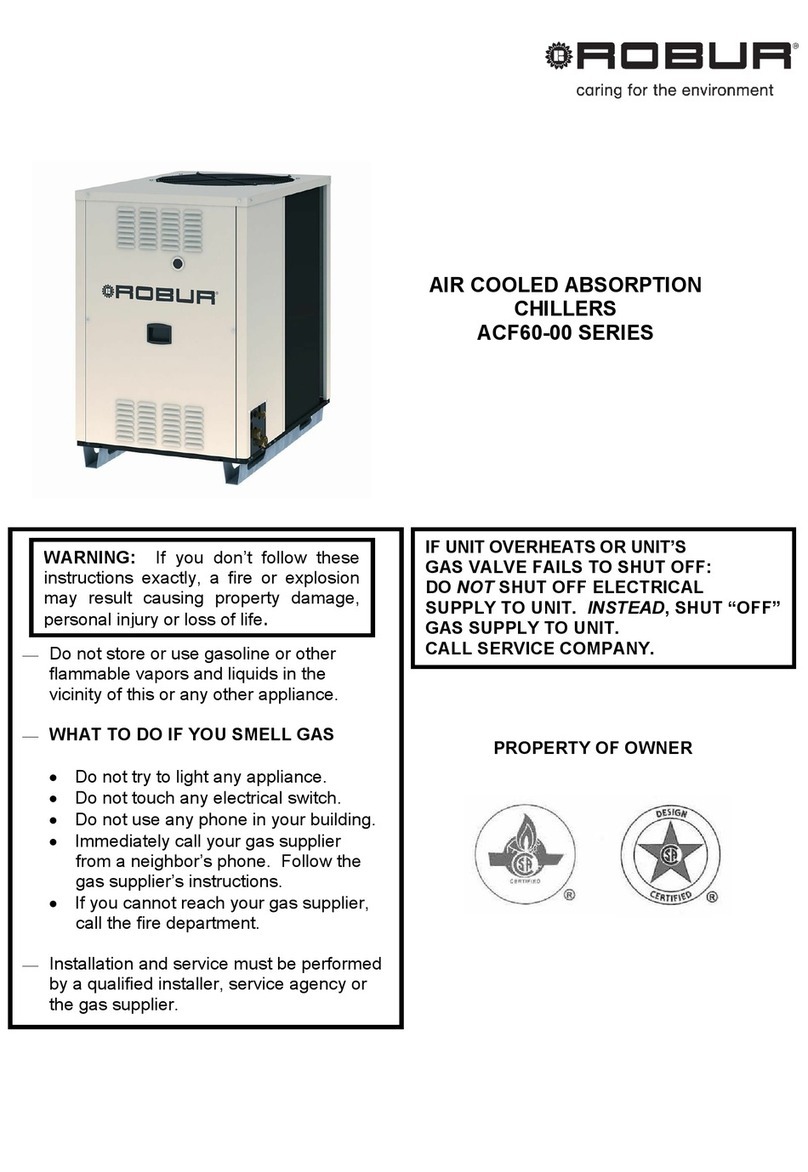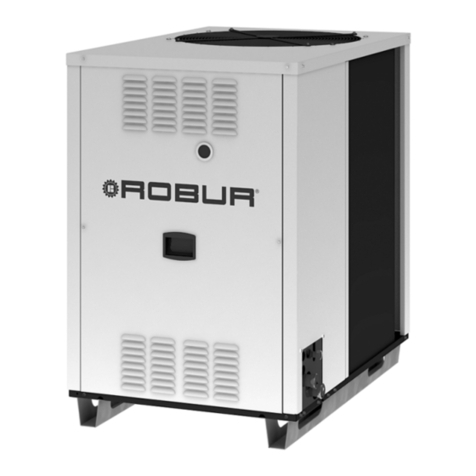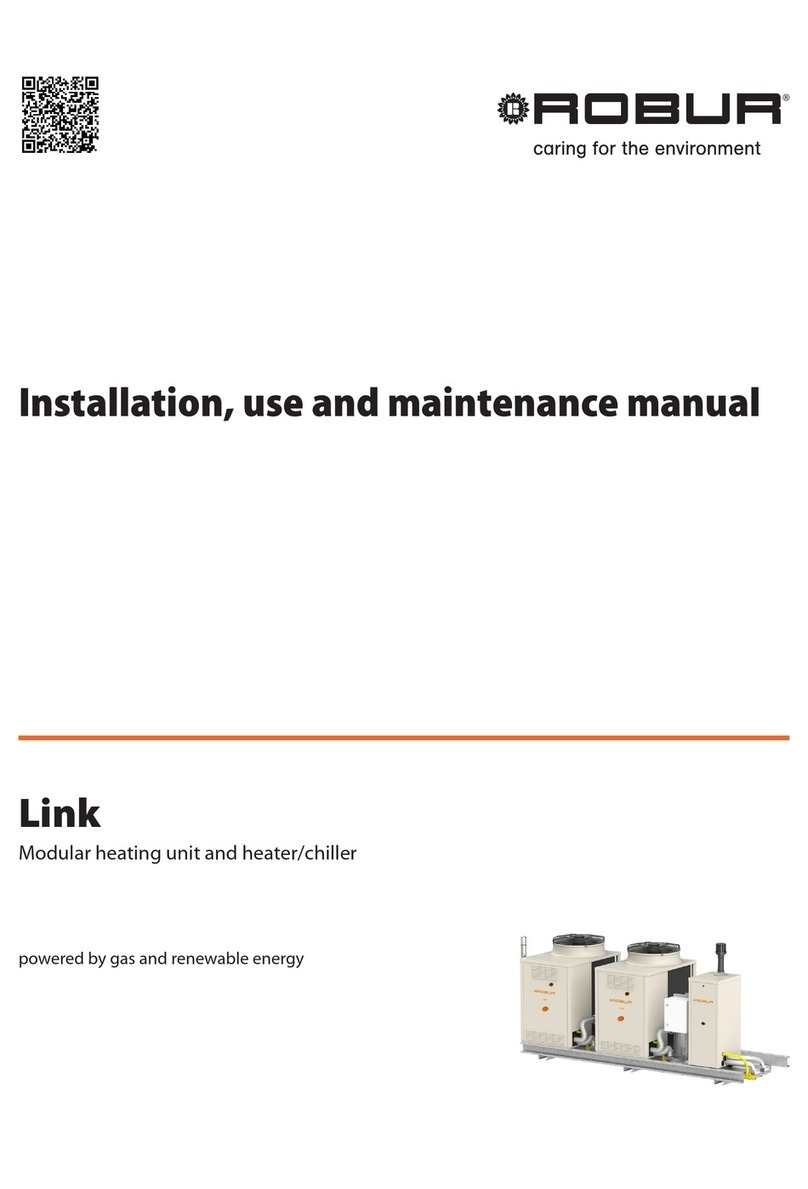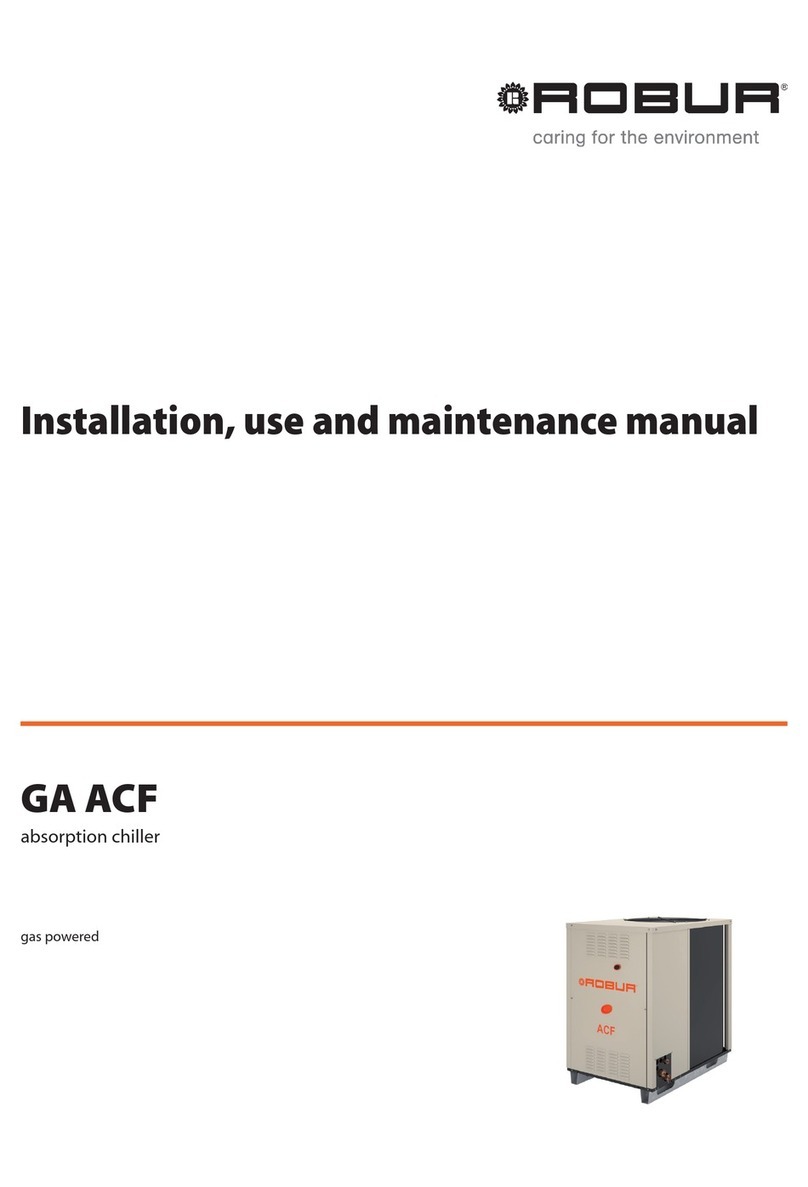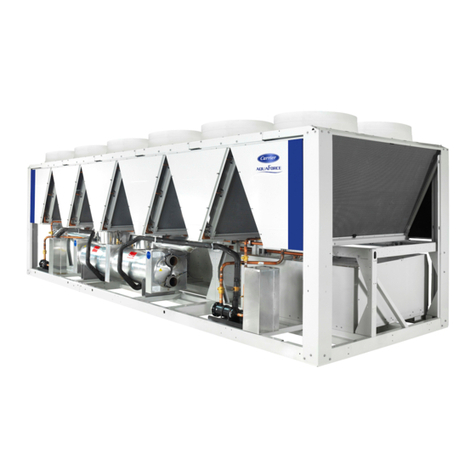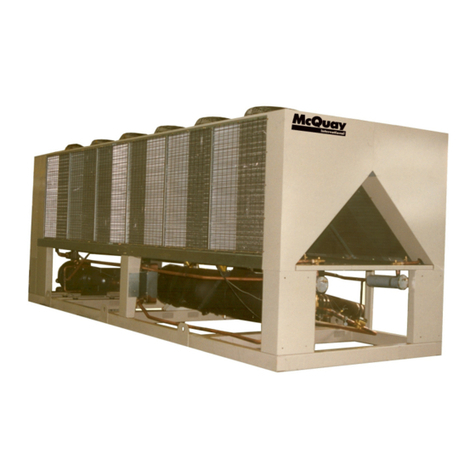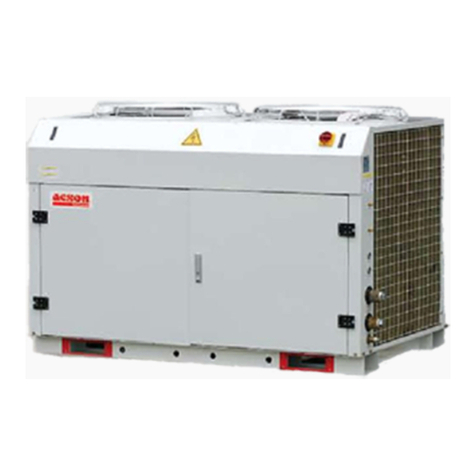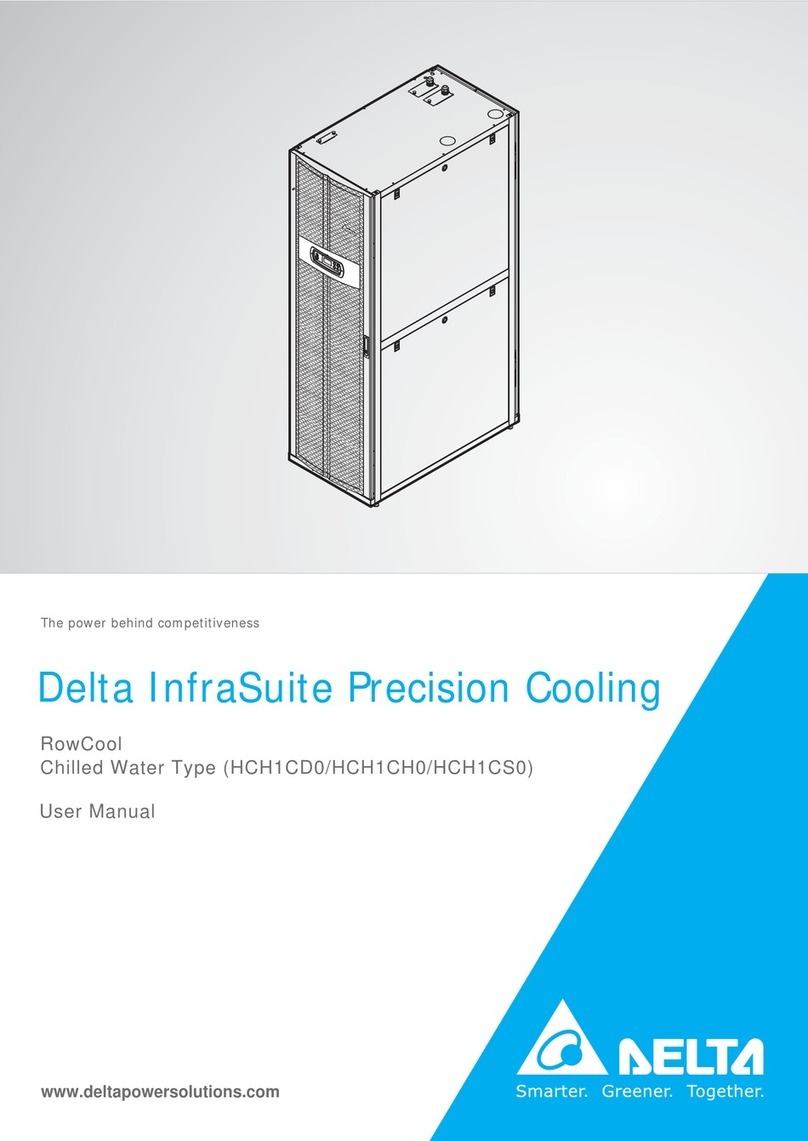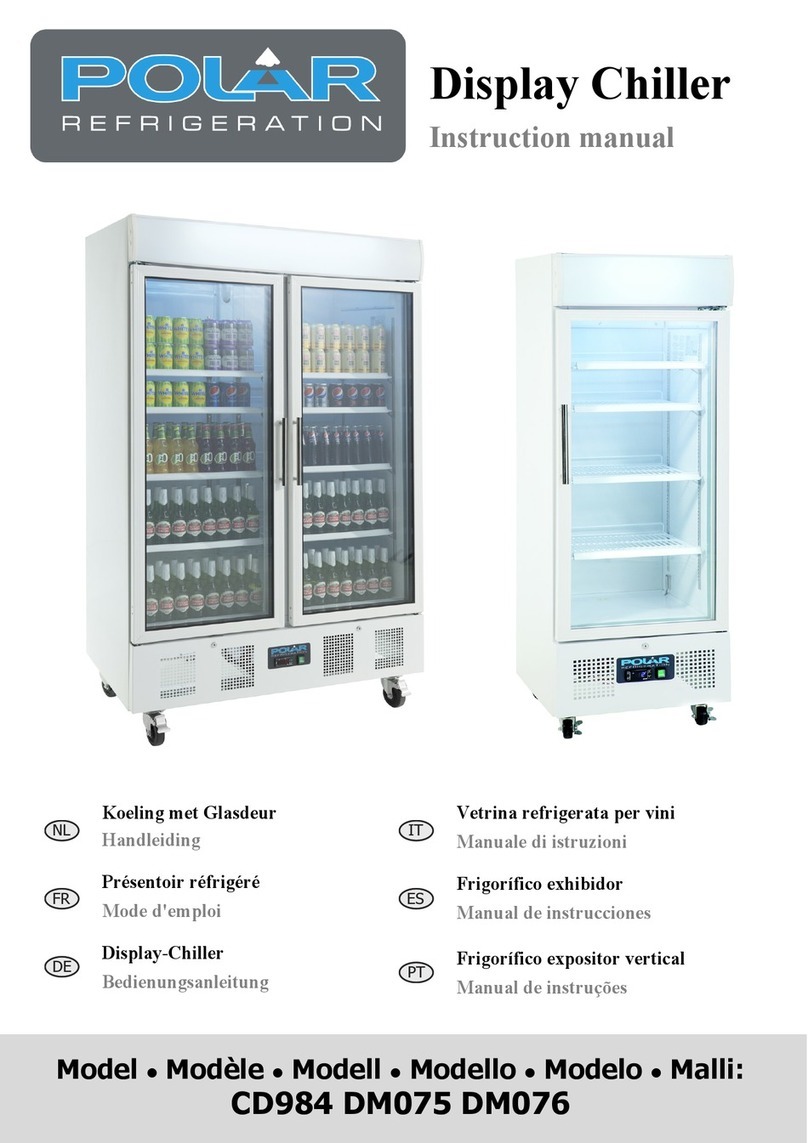Robur Gitie 2.0 ACAY Service manual

Installation, use and maintenance manual
Integrated package for outdoor installation
with absorption chiller and gas condensing boiler
Gitié 2.0 ACAY

Revision: B
Code: D-LBR888EN
This Installation, use and maintenance manual has been drawn up and printed by Robur S.p.A.; whole or partial
reproduction of this Installation, use and maintenance manual is prohibited.
The original is led at Robur S.p.A.
Any use of this Installation, use and maintenance manual other than for personal consultation must be previously
authorised by Robur S.p.A.
The rights of those who have legitimately led the registered trademarks contained within this publication are not
aected.
With the aim of continuously improving the quality of its products, Robur S.p.A. reserves the right to modify the
data and contents of this Installation, use and maintenance manual without prior notice.
DISPOSAL
The appliance and all its accessories must be disposed of separately in accordance with the regulations in force.
Use of theWEEE symbol (Waste Electrical and Electronic Equipment) indicates that this product cannot be disposed of as house-
hold waste. Proper disposal of this product helps to prevent potential negative consequences for the environment and human
health.

Installation, use and maintenance manual – Gitié 2.0 ACAY 3
TABLE OF CONTENTS
I Introduction..........................................................................
p.4
I.1 Recipients................................................................
p.4
I.2 Control device .......................................................
p.4
I.3 Available languages ............................................
p.4
II Symbols and denitions.........................................
p.4
II.1 Key to symbols ......................................................
p.4
II.2 Terms and denitions .........................................
p.4
III Warnings...................................................................................
p.4
III.1 General and safety warnings............................
p.4
III.2 Compliance.............................................................
p.6
III.3 Exclusions of liability and warranty ...............
p.6
1 Features......................................................................................
p.8
1.1 ACAY Integrated package features................
p.8
1.2 GA ACF Unit features...........................................
p.8
1.3 AY unit features.....................................................
p.8
1.4 Dimensions.............................................................
p.9
1.5 Controls..................................................................
p.11
1.6 Water pump..........................................................
p.12
2 Technical data...................................................................
p.13
2.1 ACAY Integrated package technical data
...................................................................................
p.13
2.2 GA ACF unit technical data.............................
p.15
3 Transport and positioning..................................
p.16
3.1 Warnings................................................................
p.16
3.2 Handling and lifting ..........................................
p.16
3.3 Appliance positioning ......................................
p.16
3.4 Minimum clearance distances.......................
p.17
3.5 Mounting base....................................................
p.17
4 Heating engineer...........................................................
p.17
4.1 Warnings................................................................
p.17
4.2 Hydraulic system ................................................
p.17
4.3 Fuel gas supply....................................................
p.23
4.4 Combustion products exhaust......................
p.24
4.5 AY ue gas condensate drain.........................
p.25
5 Electrical installer.........................................................
p.26
5.1 Warnings................................................................
p.26
5.2 Electrical systems ...............................................
p.26
5.3 Electrical power supply....................................
p.27
5.4 Adjustment and control...................................
p.27
6 First start-up.......................................................................
p.30
6.1 Preliminary checks.............................................
p.30
6.2 How to access the GA ACF module..............
p.31
6.3 How to access the boiler..................................
p.31
6.4 Electronic board parameters setting...........
p.31
6.5 GAHP/GA...............................................................
p.37
6.6 AY combustion parameters check................
p.38
6.7 Gas changeover ..................................................
p.40
7 Normal operation.........................................................
p.40
7.1 Warnings................................................................
p.41
7.2 Preliminary checks.............................................
p.41
7.3 Switch on and o................................................
p.41
7.4 Modifying settings.............................................
p.42
7.5 Eciency ...............................................................
p.42
8 Maintenance.......................................................................
p.42
8.1 Warnings................................................................
p.42
8.2 GAHP/GA preventive maintenance.............
p.42
8.3 Scheduled routine maintenance..................
p.43
8.4 Periods of inactivity...........................................
p.43
9 Diagnostics...........................................................................
p.44
9.1 Messages on the display..................................
p.44
9.2 Restarting a locked-out unit...........................
p.44
9.3 Operative codes..................................................
p.45
10 Appendices...........................................................................
p.49
10.1 Product che........................................................
p.49

Introduction
4
I
I INTRODUCTION
Installation, use and maintenance manual
This Manual is an integral part of the Gitié 2.0 ACAY
appliance and must be handed to the end user to-
gether with the appliance.
I.1 RECIPIENTS
This Manual is intended for:
▶
End user, for appropriate and safe use of the appliance.
▶
Qualied installer, for correct appliance installation.
▶
Planner, for specic information on the appliance.
I.2 CONTROL DEVICE
In order to work, the Gitié 2.0 ACAY appliance requires a
control device to be connected by the installer.
I.3 AVAILABLE LANGUAGES
This document is originally written in Italian and English.
Any other languages are translations of this document.
For versions of this document in other languages, see
Robur website.
II SYMBOLS AND DEFINITIONS
II.1 KEY TO SYMBOLS
DANGER
WARNING
NOTE
PROCEDURE
REFERENCE (to other document)
II.2 TERMS AND DEFINITIONS
Gitié 2.0 ACAY Appliance/Unit = equivalent terms, both
used to designate the integrated package consisting of a
GA ACF unit and a condensing boiler AY 35 or AY 50.
GA Appliance/Unit = equivalent terms, both used
to designate the gas-red absorption chiller GA (Gas
Absorption).
AY boiler/unit = equivalent terms, both used to desig-
nate the condensing boiler AY 35 or AY 50.
TAC = Technical Assistance Centre authorised by Robur.
External request = generic control device (e.g. thermo-
stat, timer or any other system) equipped with a volt-
age-free NO contact and used as control to start/stop the
GAHP/GA unit and the AY boiler.
DDC Control (Direct Digital Controller) = optional Robur
control device to manage one or more Robur appliances
in ON/OFF mode (GAHP heat pumps, GA chillers) or in
modulating mode (AY boilers).
RB100/RB200 Devices (Robur Box) = optional interface
devices complementary to DDC, which may be used to
broaden its functions (heating/cooling/DHW produc-
tion service demands and control of system components
such as third party generators, adjustment valves, water
pumps, probes).
GUE (Gas Utilization Eciency) = eciency index of gas
chiller, equal to the ratio between the chilling energy pro-
duced and the energy of the fuel used (relative to NCV, net
caloric value).
First start-up = appliance commissioning operation
which may only and exclusively be carried out by a TAC.
III WARNINGS
III.1 GENERAL AND SAFETY WARNINGS
Installer's qualications
Installation must exclusively be performed by a
qualied rm and by qualied personnel, with spe-
cic knowledge on heating, cooling, electrical sys-
tems and gas appliances, in compliance with the
laws in force in the Country of installation.
Declaration of conformity
Upon completing installation, the installing rm
shall issue to the owner/client the appliance's
workmanlike conformity declaration, according to
national/local regulations in force and the manu-
facturer's instructions/provisions.
Misuse
The appliance must only be used for the purpos-
es for which it has been designed. Any other use is
deemed hazardous. Incorrect use may aect oper-
ation, duration and safety of the appliance. Adhere
to the manufacturer's instructions.

Warnings
Installation, use and maintenance manual – Gitié 2.0 ACAY 5
III
Use of the appliance by children
The appliance can be used by children over 8 years
old, and by people with reduced physical, senso-
ry or mental capabilities, or lack of experience or
knowledge, only if they are under surveillance or
after they have received instructions regarding
safe use of the appliance and understanding the
dangers inherent in it. Children should not play
with the appliance.
Hazardous situations
Do not start the appliance in hazardous conditions,
such as: gas smell, problems with the plumbing/
electrical/gas system, parts of the appliance under
water or damaged, malfunctioning, disabling or
bypassing control and safety devices.
In case of danger, request intervention by qualied
personnel.
In case of danger, switch o the electrical power
and gas supplies only if this can be done in total
safety.
Gas component tightness
Before performing any operation on gas ducting
components, close the gas valve.
Upon completing any procedure, perform the
tightness test according to regulations in force.
Gas smell
If you smell gas:
Do not use electrical devices such as telephones,
multimeters or other equipment that may cause
sparks next to the appliance.
Shut o the gas supply by turning the valve o.
Switch o the power supply via the external dis-
connect switch in the power supply electrical pan-
el.
Use a telephone away from the appliance to ask for
intervention from qualied personnel.
Poisoning
Ensure the ue gas ducts are tight and compliant
with the regulations in force.
Upon completing any procedure, ensure the tight-
ness of the components.
Moving parts
The appliance contains moving parts.
Do not remove guards during operation, and in
any case prior to disconnecting the power supply.
Burn hazard
The appliance contains very hot parts.
Do not open the appliance and do not touch inter-
nal components before the appliance has cooled
down.
Do not touch the ue gas exhaust before it has
cooled down.
Pressure vessels
The appliance has a sealed circuit classied as pres-
sure vessel, the tightness of which is tested by the
manufacturer.
Do not carry out any intervention on the sealed cir-
cuit or on the appliance's valves.
Water-ammonia solution
The GAHP/GA unit uses the ammonia-water ab-
sorption cycle.The water-ammonia solution is con-
tained in the sealed circuit. The solution is harmful
for health if it is ingested, inhaled or comes in con-
tact with the skin.
In the event of coolant leak keep away and discon-
nect the power and gas supply (only if it is possible
to do so with no danger).
Ask for TAC intervention.
Electrocution hazard
Disconnect the electrical power supply before any
operation on appliance components.
For electrical connections exclusively use compli-
ant components and according to the specica-
tions provided by the manufacturer.
Ensure the appliance cannot be accidentally
switched back on.
Earthing
Electrical safety depends on eective earthing sys-
tem, correctly connected to the appliance and in-
stalled according to the regulations in force.
Distance from combustible or ammable mate-
rials
Do not deposit ammable materials (paper, dilu-
ents, paints, etc.) near the appliance.
Limescale and corrosion
Depending on the chemical/physical properties of
the system water, limescale or corrosion may dam-
age the appliance.
Check system sealing.
Avoid frequent top-ups.
Chloride concentration
The concentration of chlorides or free chlorine in
the system water must not exceed the values in Ta-
ble 4.3
p.22
.
Aggressive substances in the air

Warnings
6
III
Halogenated hydrocarbons containing chlorine
and uorine compounds cause corrosion. The air
of the installation site must be free from aggressive
substances.
Acid ue gas condensate
Discharge the acid condensate of combustion ue
gasincompliancewithcurrentexhaustregulations.
Switching the appliance o
Disconnecting the power supply while the appli-
ance is running may cause permanent damage to
internal components.
Except in the event of danger, do not disconnect
the power supply to switch o the appliance, but
always and exclusively act through the provided
control device.
In the event of failure
Operations on internal components and repairs
may exclusively be carried out by a TAC, using only
original spare parts.
In the event of failure of the appliance and/or
breakage of any component, do not attempt to
repair and/or restore and immediately contact the
TAC.
Routine maintenance
Proper maintenance assures the eciency and
good operation of the appliance over time.
Maintenance must be performed according to the
manufacturer's instructions (see Chapter 8
p. 42
)
and in compliance with current regulations.
Appliance maintenance and repairs may only be
entrusted to rms legally authorised to work on
gas appliances and systems.
Enter into a maintenance contract with an author-
ised specialised rm for routine maintenance and
for servicing in case of need.
Use only original parts.
Decommissioning and disposal
If the appliance is to be disposed of, contact the
manufacturer for its disposal.
Keep the Manual
This Installation, use and maintenance manual
must always accompany the appliance and must
be handed to the new owner or installer in the
event of sale or removal.
III.2 COMPLIANCE
EU directives and standards
The Gitié 2.0 integrated packages are certied in accord-
ance with EN 12309 and meet the essential requirements
of the following Directives:
▶
2016/426/EU "Gas Appliances Regulation" as amend-
ed and added.
▶
2014/30/EC "Electromagnetic Compatibility Directive"
as amended and added.
▶
2014/35/EC "Low Voltage Directive" as amended and
added.
▶
2014/68/EU "Pressure Equipment Directive" as amend-
ed and added.
▶
811/2013/EU "Energy-Related Products regulation" as
amended and added.
▶
813/2013/EU "Ecodesign requirements regulation" as
amended and added.
Furthermore, they comply with the requirements of the
following standards:
▶
EN 378 Refrigerating systems and heat pumps.
▶
EN 15502 Gas-red central heating boilers.
Other applicable provisions and standards
The design, installation, operation and maintenance of
the systems shall be carried out in compliance with cur-
rent applicable regulations, depending on the Country
and location, and in accordance with the manufacturer's
instructions. In particular, regulations regarding the fol-
lowing shall be complied with:
▶
Gas systems and equipment.
▶
Electrical systems and equipment.
▶
Heating and air conditioning systems, heat pumps
and chillers.
▶
Environmental protection and combustion products
exhaust.
▶
Fire safety and prevention.
▶
Any other applicable law, standard and regulation.
III.3 EXCLUSIONS OF LIABILITY AND
WARRANTY
Any contractual or extra-contractual liability of the
manufacturer for any damage caused by incorrect
installation and/or improper use and/or failure to
comply with regulations and with the manufactur-
er's directions/instructions shall be disclaimed.
In particular, the warranty on the appliance may be
rendered void by the following conditions:
Incorrect installation.
Misuse.
Failure to comply with the manufacturer's indica-
tions on installation, use and maintenance.
Alteration or modication of the product or any
part thereof.
Extreme operational conditions or however out-
side of the operational ranges set forth by the man-
ufacturer.
Damages caused by external agents such as salts,
chlorine, sulphur or other chemical substances
contained in the installation water or present in the

Warnings
Installation, use and maintenance manual – Gitié 2.0 ACAY 7
III
air of the installation site.
Abnormal actions transmitted to the appliance by
the system or installation (mechanical stresses,
pressure, vibrations, thermal expansion, electrical
surges...).
Accidental damages or due to force majeure.

Features
8
1
1 FEATURES
1.1 ACAY INTEGRATED PACKAGE
FEATURES
The Gitié 2.0 ACAY package consists of a GA ACF gas ab-
sorption chiller and a AY 35 (ACAY35) or AY 50 (ACAY50)
condensing boiler.
Each of the units making up the package is equipped with
an independent high head water pump.
For each of the versions (Table 1.1
p. 8
), the gas ab-
sorption chiller is available with a standard or low-noise
fan.
In all 4-pipe versions, the operation of the units can al-
ways be simultaneous or independent. In all 2-pipe ver-
sions, the operation of the units can only be alternating.
The 2-pipe versions (with a single hydraulic circuit) are
equipped with check valves serving each of the units
making up the Gitié 2.0 ACAY package.
Table1.1Gitié ACAY package versions
Version Boiler Pipes Hydraulic circuits Simultaneous operation Fan
ACAY35/4 AY 35 4 independent Yes standard
ACAY35/4 S AY 35 4 independent Yes low-noise S
ACAY35/2 AY 35 2 single No standard
ACAY35/2 S AY 35 2 single No low-noise S
ACAY50/4 AY 50 4 independent Yes standard
ACAY50/4 S AY 50 4 independent Yes low-noise S
ACAY50/2 AY 50 2 single No standard
ACAY50/2 S AY 50 2 single No low-noise S
1.2 GA ACF UNIT FEATURES
1.2.1 Operation
Based on the thermodynamic water-ammonia absorption
cycle (H20–NH3), the appliance produces chilled water
using natural gas (or LPG) as primary energy source and
dissipating heat directly to the outdoor air.
The thermodynamic cycle takes place within a hermeti-
cally sealed circuit, in welded construction, perfectly tight,
factory-tested, which does not require any maintenance
or coolant top-ups.
The GA ACF unit, for cooling systems, is able to provide
chilled water down to 3 °C.
1.2.2 Mechanical and thermo-hydraulic
components
▶
Steel sealed circuit, externally treated with epoxy
paint.
▶
Sealed combustion chamber (type C) suitable for out-
door installations.
▶
Metal mesh radiant burner, equipped with ignition
electrodes and ame detection, managed by an elec-
tronic ame control box.
▶
Titanium stainless steel shell-and-tube water exchang-
er (evaporator), externally insulated.
▶
Air exchanger (condenser) with nned coil, with steel
pipe and aluminium ns.
▶
Low power consumption refrigerant uid oil pump.
▶
Variable-ow microprocessor-controlled helicoidal
motor-fan.
▶
Standard or low noise S fan.
1.2.3 Control and safety devices
▶
S61 electronic board with microprocessor, LCD display
and knob.
▶
Circuit water ow switch.
▶
Generator limit thermostat, with manual reset.
▶
Automatically resettable ue gas thermostat.
▶
Dierential ue gas pressure switch on the combus-
tion circuit.
▶
Sealed circuit safety relief valve.
▶
Bypass valve, between high and low-pressure circuits.
▶
Ionization ame control box.
▶
Double shutter electric gas valve.
1.3 AY UNIT FEATURES
1.3.1 Operation
The AY appliances are condensing boilers suitable for
both outdoor and indoor installation, capable of produc-
ing hot water up to 88 °C.
There are two models that can be part of the Gitié 2.0 ACAY
unit: AY 35 and AY 50.
1.3.2 Mechanical and thermo-hydraulic
components
▶
Integrated spiral single tube stainless steel heat ex-
changer.
▶
Premix modulating burner with 1:9 ratio (AY 35), 1:10
(AY 50).
▶
Automatic air vent valve.
▶
High eciency water pump.
▶
System drain tap.
▶
Water temperature probes.
▶
Condensate drain siphon.
▶
Flue gas exhaust duct with relevant terminal, for type
B53P conguration.
1.3.3 Control and safety devices
▶
Flue safety thermal fuse.
▶
Gas solenoid valve.
▶
Safety thermostat.

Features
Installation, use and maintenance manual – Gitié 2.0 ACAY 9
1
▶
Safety valve (3,5 bar).
▶
Water differential pressure switch.
▶
Expansion tank.
▶
Outdoor temperature probe.
1.3.4 INAIL safety appliances
The kit is only available on appliances intended for the
Italian market.
1.4 DIMENSIONS
Figure1.2Dimensions (standard fan)
A Centre distance of holes for front vibration damper supports B Centre distance of holes for rear vibration damper supports
767 471
471 (A)719 (B)
1238
95
1050 (A)
617 (B)
1425
1278
1445
1775

Features
10
1
Figure1.3Dimensions (low-noise fan)
A Centre distance of holes for front vibration damper supports B Centre distance of holes for rear vibration damper supports
767 471
471 (A)719 (B)
1238
95
1050 (A)
617 (B)
1425
1278
1513
1775
Figure1.4Gitié /2 service plate - Hydraulic/gas connections detail
OUT Water outlet connection Ø 1 1/4" F
IN Water inlet connection Ø 1 1/4" F
SC AY condensate drain connection (outside diameter 25 mm, inside
21 mm)
GAS Gas connection Ø 3/4" M
100 355
43
160
100 305
459
59
119
185
GAS
IN OUT
SC

Features
Installation, use and maintenance manual – Gitié 2.0 ACAY 11
1
Figure1.5Gitié /4 service plate - Hydraulic/gas connections detail
OUT-AY AY water outlet connection Ø 1 1/4" F
IN-AY AY water inlet connection Ø 1 1/4" F
OUT-GAHPGA GAHP/GA water outlet connection Ø 1 1/4" F
IN-GAHP/GA GAHP/GA water inlet connection Ø 1 1/4" F
SC AY condensate drain connection (outside diameter 25 mm, inside
21 mm)
GAS Gas connection Ø 3/4" M
100 355
43
160
100 305
459
59
119
185
GAS
IN-GAHP/GA
OUT-GAHP/GA OUT-AY
IN-AY
SC
Figure1.6Service plate - Detail of bottom plate
A AY front panel
B Boiler safety valve drain outside Ø 20 mm, inside Ø 14 mm
159
Ø22
266
B
A
1.5 CONTROLS
1.5.1 Control device
The appliance may only work if it is connected to a control
device, selected from:
1. DDC control
2. external requests
1.5.2 DDC Controller
The DDC control is able to manage one or more Robur ap-
pliances in ON/OFF mode (GAHP heat pumps, GA chillers)
or modulating mode (AY boilers).
The main functions are:
▶
Adjustment and control of one (or more) Robur units
of the absorption line (GAHP, GA, AY).
▶
Data display and parameters setting.
▶
Time programming.
▶
Heating curve control.
▶
Diagnostics.
▶
Errors reset.
▶
Possibility to interface with a BMS.
DDC functionality may be extended with auxiliary Robur
devices RB100 and RB200 (e.g. service requests, DHW pro-
duction, third party generator control, probe control, sys-
tem valves or water pumps, ...).
For further details refer to the DDC, RB100, RB200
manuals and the design manual.
1.5.3 External requests
The appliance may also be controlled via generic request
devices (e.g. thermostats, clocks, switchs, contactors...) t-
ted with voltage-free NO contacts. This system only pro-
vides elementary control, without some of the important
functions of DDC control. Control of the cascade between
GAHP/GA and AY is dependent on the opening/closing
of the requests to the appliances making up the Gitié 2.0

Features
12
1
ACAY (GA ACF and AY boiler). The AY boiler retains the
possibility of operating in power modulation.
For connection of the selected device to the appli-
ance's electronic board please refer to Paragraph
5.4
p.27
.
1.6 WATER PUMP
1.6.1 Water pump characteristic curves
Figure1.7Oversized pressure head water pump characteristic curves
1.9 m
1.1 m
10 m
6.4 m
0.5 m0.5 m
2.8 m
5 m
8.1 m
3.8 m
0.5 m
3.8 m
10 m
H
/ m
0
2
4
6
8
∆ p
/ kPa
0
20
40
60
80
P
/ kW
0
0,05
0,1
Q
/ m³/h
0123456789

Technical data
Installation, use and maintenance manual – Gitié 2.0 ACAY 13
2
2 TECHNICAL DATA
2.1 ACAY INTEGRATED PACKAGE TECHNICAL DATA
Table2.1Gitié ACAY technical data
ACAY35/2 ACAY35/2 S ACAY35/4 ACAY35/4 S ACAY50/2 ACAY50/2 S ACAY50/4 ACAY50/4 S
Heating operation
Heat input real kW 34,0 50,0
minimum kW 4,1 5,0
Operating point 80/60 Nominal heat input
eciency % 98,2 98,4
eective
power kW 33,4 49,2
Operating point 50/30 Nominal heat input eciency % 106,4 106,8
Operating point Tr = 47 °C Heat input 30% eciency % 102,1 102,8
Operating point Tr = 30 °C Heat input 30% eciency % 108,6 108,8
Heat losses
with burner o % 0,03 0,05
to ue in operation % 2,40 2,10
to casing in operation % 0,25 0,10
Water ow rate 4 pipes nominal (AY) l/h 2600 2350
minimum (AY) l/h 1200 1500
Water ow rate 2 pipes nominal l/h 2600 2350
minimum l/h 1200 1500
Pressure drop heating mode AY at nominal
water ow bar 0,57 (1)
Residual pressure head at nominal ow rate version /4 AY bar - 0,44 - 0,44
version /2 bar 0,42 - 0,42 -
Hot water outlet temperature maximum for heating °C 88
maximum for DHW °C 88
Hot water inlet temperature maximum for heating °C 70
maximum for DHW °C 70
Outdoor temperature (dry bulb) maximum °C 45
minimum °C -25
Cooling mode
Heat input real kW 25,0
Cooling output for each unit Outdoor tempera-
ture/Water outlet
temperature
A35W7 kW 17,7
(1) For ows other than nominal see design manual, Paragraph“Pressure losses”.
(2) Maximum sound pressure levels in free eld, with directivity factor 2, obtained from the sound power level in compliance with standard EN ISO 9614.
(3) Sound power values detected in compliance with the intensity measurement methodology set forth by standard EN ISO 9614.

Technical data
14
2
ACAY35/2 ACAY35/2S ACAY35/4 ACAY35/4S ACAY50/2 ACAY50/2S ACAY50/4 ACAY50/4S
GUE eciency Outdoor tempera-
ture/Water outlet
temperature
A35W7 % 71
Cold water temperature (outlet) minimum °C 3
Cold water temperature (inlet) maximum °C 45
minimum °C 8
Cold water ow nominal l/h 2770
minimum l/h 2500
Pressure drop cooling mode GAHP/GA at nominal
water ow bar 0,29 (1)
Residual pressure head at nominal ow rate version /4 ACF bar - 0,72 - 0,72
version /2 bar 0,70 - 0,70 -
Outdoor temperature maximum °C 45
minimum °C 0
Electrical specications
Power supply
voltage V 230
type - single-phase
frequency Hz 50
Electrical power absorption nominal kW 0,95 1,00 1,17 1,22 0,95 1,00 1,20 1,25
Degree of protection IP - 25
Installation data
Gas consumption
G20 natural gas (nominal) m³/h 6,28 7,97
G25 (nominal) m³/h 7,29 9,26
G30 (nominal) kg/h 4,65 5,91
G31 (nominal) kg/h 4,61 5,85
Dimensions
width mm 1425
height mm 1445 1513 1445 1513 1445 1513 1445 1513
depth mm 1238
Gas connection thread “ 3/4
type - M
Water tting thread “ 1 1/4
type - F
Type of installation (boiler) type of installation - B23, B23P, B33, B53
Boiler ue gas exhaust diameter (Ø) mm 80
residual head Pa 91 100
Weight in operation kg 447 457 447 457 467 457 467
minimum storage temperature °C -30
sound pressure Lpat 5 metres (max) dB(A) 57,6 (2) 53,0 (2) 57,6 (3) 53,0 (3) 57,6 (3) 53,0 (3) 57,6 (3) 53,0 (3)
sound power Lw(max) dB(A) 79,6 (3) 75,0 (3) 79,6 (3) 75,0 (3) 79,6 (3) 75,0 (3) 79,6 (3) 75,0 (3)
(1) For ows other than nominal see design manual, Paragraph“Pressure losses”.
(2) Maximum sound pressure levels in free eld, with directivity factor 2, obtained from the sound power level in compliance with standard EN ISO 9614.
(3) Sound power values detected in compliance with the intensity measurement methodology set forth by standard EN ISO 9614.

Technical data
Installation, use and maintenance manual – Gitié 2.0 ACAY 15
2
ACAY35/2 ACAY35/2S ACAY35/4 ACAY35/4S ACAY50/2 ACAY50/2S ACAY50/4 ACAY50/4S
expansion tank volume l 10
maximum ow rate of boiler ue gas condensate l/h 3,4 5,0
maximum water pressure in operation bar 4,0
water content inside the appliance l 11 14
NOxemission class AY - 6
(1) For ows other than nominal see design manual, Paragraph“Pressure losses”.
(2) Maximum sound pressure levels in free eld, with directivity factor 2, obtained from the sound power level in compliance with standard EN ISO 9614.
(3) Sound power values detected in compliance with the intensity measurement methodology set forth by standard EN ISO 9614.
2.2 GA ACF UNIT TECHNICAL DATA
Table2.2GA ACF sealed circuit technical data
ACF60-00 ACF60-00 S
General information
Refrigerating uid (1) ammonia R717 kg 6,8
water H2O kg 10,0
maximum pressure of the refrigerating circuit bar 32
PED data
Components under pressure
generator l 18,6
leveling chamber l 11,5
evaporator l 3,7
refrigerant volume changer l -
solution refrigerant absorber l 6,3
solution pump l 3,3
test pressure (in air) barg48,5
maximum pressure of the refrigerating circuit barg32
lling ratio kg of NH3/l 0,157
uid group - 1°
(1) Tolerance ±5%.

Transport and positioning
16
3
3 TRANSPORT AND POSITIONING
3.1 WARNINGS
Damage from transport or installation
The manufacturer shall not be liable for any dam-
age during appliance transport and installation.
On-site inspection
Upon arrival at the site, ensure there is no transport
damage on packing, metal panels or nned coil.
After removing the packing materials, ensure the
appliance is intact and complete.
Packing
Only remove the packing after placing the appli-
ance on site.
Do not leave parts of the packing within the reach
of children (plastic, polystyrene, nails...) since they
are potentially dangerous.
Weight
The crane and lifting equipment must be suitable
for the load.
Do not stand under suspended loads.
3.2 HANDLING AND LIFTING
▶
Always handle the appliance in its packing, as deliv-
ered by the factory.
▶
Do not remove the protective cap on the boiler ue
gas outlet to prevent water and/or foreign bodies from
entering the appliance.
▶
To lift the appliance use straps or slings inserted in the
holes of the base (Figure 3.1
p.16
).
▶
Use lifting beams to avoid damaging the outer panels
and nned coil (Figure 3.1
p.16
).
▶
Comply with safety regulations at the installation site.
Figure3.1Instruction for lifting
In the event of handling with forklift or pallet truck,
comply with the handling instructions shown on
the packing.
3.3 APPLIANCE POSITIONING
Do not install inside a room
The appliance is type-approved for external
installation.
Do not install inside a room, not even if it has open-
ings.
In no event start the appliance inside a room.
Gitié 2.0 ACAY unit ventilation
The aerothermic appliance requires a large space,
ventilated and free from obstacles, to enable
smooth ow of air to the nned coil and free air
outlet above the mouth of the fan, with no air re-
circulation.
Incorrect ventilation may aect eciency and
cause damage to the appliance.
The manufacturer shall not be liable for any incor-
rect choices of the place and setting of installation.
3.3.1 Where to install the appliance
▶
The appliance may be installed at ground level, on a
terrace or on a roof, compatibly with its dimensions
and weight.
▶
It must be installed outside buildings, in an area of nat-
ural air circulation, outside the dripping path of drain-
pipes or similar. It does not require protection from
weathering.
▶
No obstruction or overhanging structure (e.g. pro-
truding roofs, canopies, balconies, ledges, trees) shall
interfere either with the air owing from the top of the
appliance or with the exhaust ue gas.
▶
The appliance's ue gas exhaust must not be immedi-
ately close to openings or air intakes of buildings, and
must comply with safety and environmental regula-
tions.
▶
Do not install near the exhaust of ues, chimneys or
hot polluted air. In order to work correctly, the appli-
ance needs clean air.
3.3.2 Acoustic issues
Pre-emptively assess the appliance's sound eect in
connection to the site, taking into account that build-
ing corners, enclosed courtyards, restricted spaces may
amplify the acoustic impact due to the reverberation
phenomenon.

Heating engineer
Installation, use and maintenance manual – Gitié 2.0 ACAY 17
4
3.4 MINIMUM CLEARANCE DISTANCES
3.4.1 Distances from combustible or ammable
materials
Keep the appliance away from combustible or ammable
materials or components, in compliance with applicable
regulations.
3.4.2 Clearances around the appliance
The minimum clearance distances shown in Figure
3.2
p. 17
(bar any stricter regulations) are required for
safety, operation and maintenance.
Figure3.2Clearances
800
450
600
300
3.5 MOUNTING BASE
3.5.1 Mounting base constructive features
Place the appliance on a level at surface made of re-
proof material and able to withstand its weight.
3.5.2 Installation at ground level
Failing a horizontal supporting base, make a at and level
concrete base, at least 100-150 mm larger than the appli-
ance size per side.
3.5.3 Installation on terrace or roof
▶
The structure of the building must support the total
weight of the appliance and the supporting base.
▶
If necessary, provide a maintenance walkway around
the appliance.
3.5.4 Anti vibration mountings
Although the appliance's vibrations are minimal, res-
onance phenomena might occur in roof or terrace
installations.
▶
Use anti-vibration mountings.
4 HEATING ENGINEER
4.1 WARNINGS
Read the warnings in Chapter III.1
p. 4
, pro-
viding important information on regulations and
on safety.
Compliance with installation standards
Installation must comply with applicable regula-
tions in force, based on the installation Country
and site, in matters of safety, design, implementa-
tion and maintenance of:
heating systems
cooling systems
gas systems
ue gas exhaust
ue gas condensate drain
Installation must also comply with the manufactur-
er's provisions.
4.2 HYDRAULIC SYSTEM
The hydraulic installer must make the hydraulic connec-
tion circuit to the system.
The installer must provide for the construction of a suita-
bly sized hydraulic connection circuit, taking into account:
A. of the following indications:
Use pipes for heating/cooling systems, protected
from weathering and freezing, insulated for ther-
mal dispersion.
Sizing of the pipes, according to the supplied circu-
lator, must grant the nominal water ow required
for the correct operation of the system.
When using glycol water, take this into account
when selecting the pipe material and calculating
the additional pressure drop generated by the
presence of glycol (Paragraph 4.2.11.2
p.22
).
B. of the residual head data reported in Paragraph
2
p.13
.
Connect the outlet of the boiler safety valve (Figure
1.6
p.11
) to a suitable drain. The manufacturer is
not liable for any damage caused by the opening
of the safety valve in the event of system overpres-
sure.

Heating engineer
18
4
4.2.1 Primary and secondary circuit
In many cases it is advisable to divide the hydraulic system
into two parts, primary and secondary circuit, uncoupled
by a hydraulic separator, or possibly by a tank that also
acts as inertial tank/buer.
See for example the diagrams in Paragraph 4.2.8
p.20
.
4.2.2 Minimum water content
High thermal inertia is conducive to ecient appliance
operation. Very short ON/OFF cycles are to be avoided.
▶
If necessary, provide for an inertial volume, to be suita-
bly sized (see design manual).
4.2.3 4-pipe version hydraulic connections
on the right, at the bottom, connection plate (Figure
1.5
p.11
).
▶
OUT-AY AY water outlet connection Ø 1 1/4" F
▶
IN-AY AY water inlet connection Ø 1 1/4" F
▶
OUT-GAHPGA GAHP/GA water outlet connec-
tion Ø 1 1/4" F
▶
IN-GAHP/GA GAHP/GA water inlet connection Ø 1
1/4" F
▶
SC Condensate drain connection (outside diameter
25 mm, inside 21 mm)
4.2.4 2-pipe version hydraulic connections
on the right, at the bottom, connection plate (Figure
1.4
p.10
).
▶
OUT Water outlet connection Ø 1 1/4" F
▶
IN Water inlet connection Ø 1 1/4" F
▶
SC Condensate drain connection (outside diameter
25 mm, inside 21 mm)
4.2.5 Pipe cleaning
Pipe cleaning
Before connecting the appliance,accurately wash
the water and gas piping and any other system
component, removing any residue.
4.2.6 Minimum components of water circuit
Always provide, near the appliance:
▶
on water piping, both outlet and inlet
2 antivibration joints on water ttings
2 pressure gauges
2 isolation ball valves
▶
on the inlet water piping
1 separator lter
1 Flow regulator valve
▶
on the water outlet pipe (only for 4-pipe version and
only for the GAHP/GA unit)
1 safety valve (3,5 bar)
1 expansion tank
The AY unit is equipped with its own 10 l internal
expansion tank and a safety valve, which in the
2-pipe version are also eective for the GAHP/
GA unit. Depending on the water content of the
system, assess the need for additional expansion
tanks.
4.2.7 System lling
For the calculation of the total water content to be
loadedin thesystemit is necessary toadd the water
content of the appliance (Paragraph 2.1
p. 13
)
and of the distribution terminals to the water con-
tent in the pipes and in other elements that make
up the system (tanks, hydraulic separators, etc.).
Proceed with the lling of the system as follows.
A lling tap on the system must be provided for ll-
ing the system.
At the rst power supply of the boiler and each
time the power supply is restored, an automatic
system venting cycle is activated. The display will
show the code F33 for the entire duration of the
cycle (5 minutes for the rst power supply, 2 min-
utes for the following ones).
To access the display of the boiler, remove the front
panel of the boiler, as shown in Figure 6.2
p.31
.
4.2.7.1 GA ACF
How to ll up the system
After completing all water, electrical and gas
connections:
1. Pressurise (at least 1,5 bar) and vent the hydraulic
circuit.
2. Let water ow (with burner o) by activating the
service request and deactivating it before the
burner is ignited.
3. Check and clean the lter on the inlet pipe.
4. Repeat items 1, 2 and 3 until the pressure has stabi-
lised (at least 1,5 bar).
4.2.7.2 AY 35
1. Slightly loosen the cap of the jolly valve placed on the
top of the condensing block (Figure 4.1
p.19
) to re-
lease the air from the top of the boiler.
2. Open the system lling valve (to be provided on the
system) and let out all the air.
3. Check with pressure gauge that system pressure
reaches 1,5 bar.
4. Open the automatic air vent valves on the system, if
any, and check the air venting process.
5. Make sure that the unit is energized.
6. Send an operating request to the unit for a few sec-
onds. The water pump will be immediately activated.
7. Remove the request before the burner is activated.
The water pump will continue to circulate the water
for the post-circulation time.
8. If, after the above operations, a decrease in system wa-
ter pressure is observed, open again the system lling
tap until the system pressure reaches 1,5 bar.
9. Repeat items 6, 7, 8 until the pressure has stabilised (at
least 1,5 bar).

Heating engineer
Installation, use and maintenance manual – Gitié 2.0 ACAY 19
4
10.After the operation, make sure that the system lling
tap is tightly closed.
Once the lling operation has been completed,
close the cap of the jolly valve on the condensing
block, to avoid water leaks.
To start the water pump only, with the boiler pow-
ered, press the key (Figure 7.1
p.40
): the
symbol will appear on the display; after a few
seconds turn o the boiler by pressing the
key again (the symbol will appear on the dis-
play). The water pump will remain in operation for
a few minutes. Repeat the operation several times
until the pressure of the circuit remains unchanged.
Figure4.1Cap of the jolly valve on condensing block
4.2.7.3 AY 50
1. Slightly loosen the cap of the jolly valve located at
the top of the condensing block (detail 1, Figure
4.2
p.19
) to let the air out from the highest point of
the boiler.
2. Check that the air vent valves in the system are not
blocked.
3. Connect a rubber hose to the drain tap (detail 2, Figure
4.2
p.19
).
4. Open the drain tap (detail 2, Figure 4.2
p. 19
)
counterclockwise.
5. Open the system lling tap (to be provided on the sys-
tem) and let all the air out. Close it when the air is all
out, replaced by a constant water ow.
6. Pressurize the hydraulic system, making sure that the
water pressure indicated by the pressure gauge is not
less than 1,5 bar.
7. Make sure that the unit is energized.
8. Send an operating request to the unit for a few sec-
onds. The water pump will be immediately activated.
9. Remove the request before the burner is activated.
The water pump will continue to circulate the water
for the post-circulation time.
10.If, after the above operations, a decrease in system wa-
ter pressure is observed, open again the system lling
tap until the system pressure reaches 1,5 bar.
11.Repeat steps 8, 9 and 10 until the pressure has stabi-
lised (at least 1,5 bar).
12.After the operation, close the lling tap.
Once the lling operation has been completed,
close the cap of the jolly valve on the condensing
block, to avoid water leaks.
To start the water pump only, with the boiler pow-
ered, press the key (Figure 7.1
p.40
): the
symbol will appear on the display; after a few
seconds turn o the boiler by pressing the
key again (the symbol will appear on the dis-
play). The water pump will remain in operation for
a few minutes. Repeat the operation several times
until the pressure of the circuit remains unchanged.
Figure4.2Air-vent valve
1 Cap of the
jolly valve
2 Tap
2
1
4.2.7.4 Water pump air vent (only for 2 pipe
appliances)
How to vent the water pumps of 2 pipe appli-
ances
1. Turn o the system by means of provided control de-
vices and wait for the water pumps to stop.
2. Disassemble the front panel of the boiler.
3. Close the shut-o valve on the outlet and open the up-
per or left vent valve (Figure 4.3
p.20
, detail B).
4. When the air is all out, replaced by a constant ow of
water, close the upper or left vent valve and open the
shut-o valve on the outlet.
5. Close the shut-o valve on the inlet and open the low-
er or right vent valve (Figure 4.3
p.20
, detail C).
6. When the air is all out, replaced by a constant ow of
water, close the lower or right vent valve and open the
shut-o valve on the inlet.
7. Reactivate the system and let water ow (with burner

Heating engineer
20
4
o).
8. If the air vent has been properly completed, reassem-
ble the front panel of the boiler. If not, repeat the pro-
cedure from step 3.
The correct lling and air venting of the hydraulic
system are fundamental to ensure reliability over
time of the mechanical components, in particular
the circulation pumps.
Figure4.3Pump/Roma valve assembly on Gitié appliances
A AY Roma valve
B Air vent (internal circuit)
C Air vent (system)
D Flexible hose
E AY water pump
F GAHP A water pump
G Return pipe
H Delivery pipe
J GAHP A Roma valve
A
B
C
J
GH
C
B
D
H
F
E
4.2.8 Schematic hydraulic diagrams
Figure4.4Hydraulic diagram Gitié ACAY /2
1 Anti-vibration connection
2 Pressure gauge
3 Flow regulation valve
4 Sludge lter
5 Shut-o valve
6 Buer tank (and hydraulic separator)
7 Heating/Cooling circuit water pump
8 DDC panel
9 Outdoor temperature probe
A Gas connection
P
P
7
135
2
6
A
8
9
4
T
Table of contents
Other Robur Chiller manuals
Popular Chiller manuals by other brands
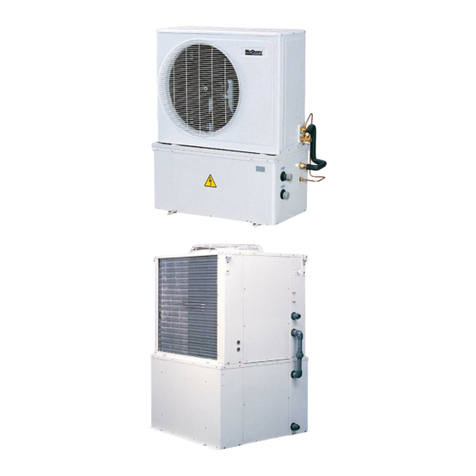
McQuay
McQuay MAC040A Installation and maintenance manual
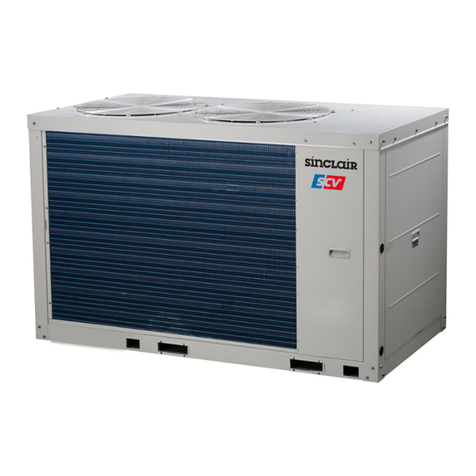
Sinclair
Sinclair SCV EB Series Installation and user manual
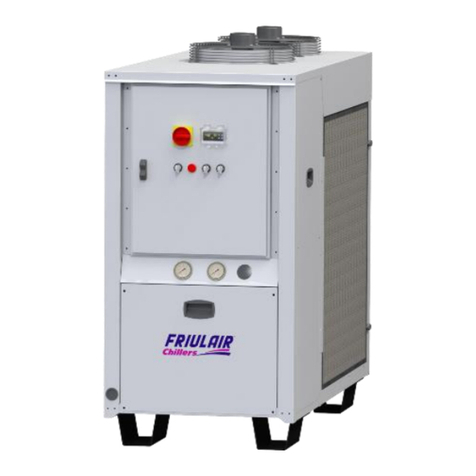
FRIULAIR
FRIULAIR CWE Series User and maintenance manual
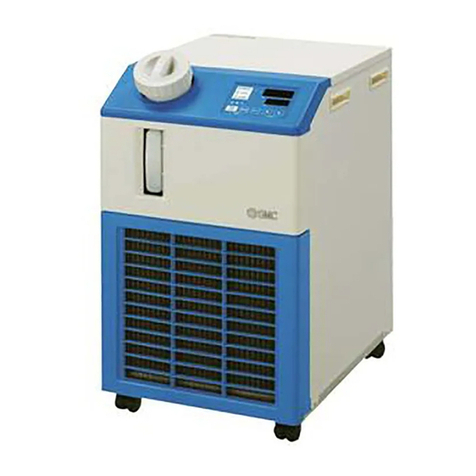
SMC Networks
SMC Networks HRS Series manual
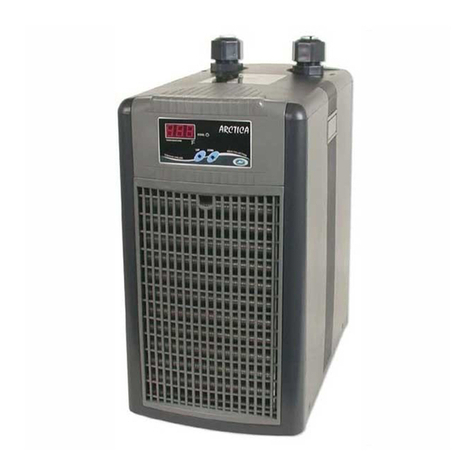
Arctica
Arctica DBA-150 owner's manual
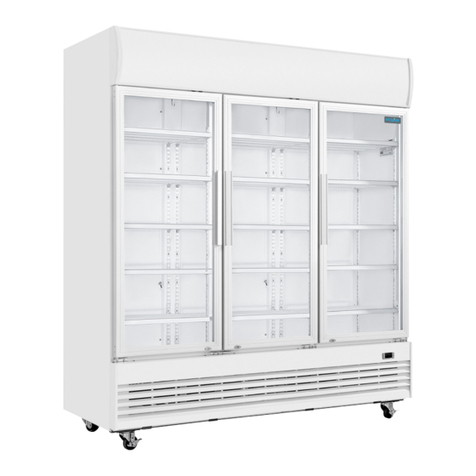
Polar Electro
Polar Electro GE769 instruction manual
